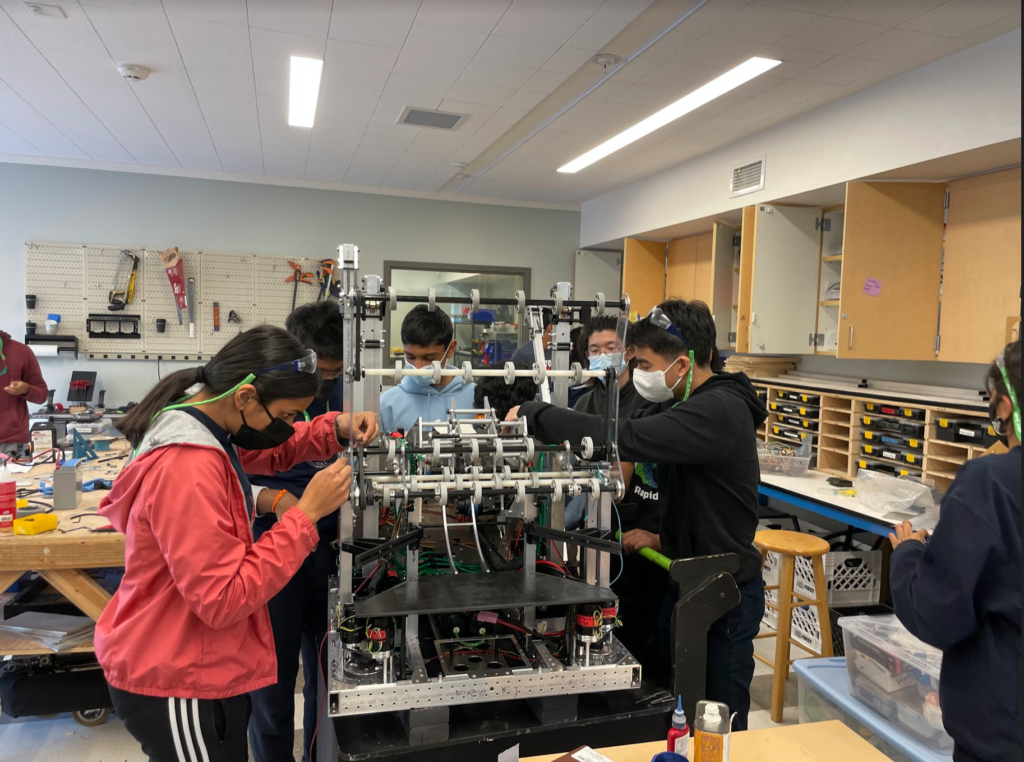Sophomore Naveed Kasnavi, the hardware lead for the school’s FRC team 649 MSET Fish, tightened the last screw on the team’s robot on a late February evening. The robot, named Cowfish, was finally assembled for the team’s two regionals the team is competing in: the San Francisco Regional on March 17 and the Silicon Valley Regional on April 7.
Every year, the team designs a robot to compete in a complicated robot game, consisting of various tasks that award points. This year’s game is called Rapid React, and the main objective is to score points by shooting 9.5-inch balls into two hoops — one low and one high — placed in the center of the field. At the end of the match, teams must perform a “monkey bar” move, where the robot grabs onto overhead bars that increase in height and reach as high as possible.
The team hopes to build upon the success they had during the 2020-21 season, where they received the Excellence in Engineering Award and were the Skills Challenge Finalist for the Carbon Group.
In order to replicate the results of last season, the team has strived to complete all sections of the robot comfortably and thoroughly. Kasnavi pointed out that the team finalized their design for the robot by the fourth week of the season and fully assembled it a week later. They planned to have a fully functional robot by the San Francisco Regional and continue to improve it for succeeding competitions.
“We allocated a set number of weeks for software and electronics, hardware and testing, which we feel should propel us through the competition season,” Kasnavi said.
In the season so far, the team has faced its fair share of unusual challenges.
Due to remodeling work, resources like the engineering lab were not available for a portion of this season, demanding more efficiency and planning to fill these holes. As such, Kasnavi said that the team needed to be stricter with not only deadlines but also team coordination, especially with several new underclassmen on the team.
“In our first season, we had to constantly show up, participate and stay engaged with the robot in order to learn and grow,” Kasnavi said. “My friends and I are pushing that same mentality onto our new members. We want to guide and encourage them but not do their assignment, and with time, they can grow to be extremely strong, independent team members.”
The team has also adapted to the collapsed roof of their FRC robotics room, which has yet to be repaired. After a section of their ceiling broke during a storm in October, the FRC team had to move all of their parts to the unaffected FTC room, a much smaller area with fewer tools, making it harder to stay efficient.
Finally, after former team lead senior Sajiv Shah stepped down from the role at the end of the first semester, the team is now working under the leadership of a new team lead, senior Arya Vasani. Shah remains on the team, though he has been unable to commit the time necessary for team lead due to his engineering job at Whisper Aero.
“I’ve been trying to improve the commitment of the members,” Vasani said. “I think COVID-19 made it easy to forget what being a Worlds-caliber team meant, so I’m pushing for that common mindset.”
As a member of FRC for all four years of high school, Vasani is proud of the current footing that the current FRC team has.
“Over the years, we’ve built up a lot of resources to get to our current position,” Vasani said. “I’m hopeful that with practice and coordination, we will learn to leverage our strengths and resources to their fullest so we can dominate in tournaments.”


























